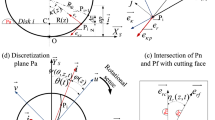Abstract
To achieve high quality and precision of machining products, the machining error must be examined. The machining error, defined as the difference between designed surface and the actual tool, is generally caused by tool deflection and wear, thermal effects and machine tool errors. Among these error sources, tool deflection is usually known as the most significant factor. The tool deflection problem is analyzed using the instantaneous cutting forces on the cutting edge. This study presents a model of the machining error caused by tool deflection in the internal boring process. The machining error prediction model was described by the surface response method using overhang, feed per revolution and depth of cut as the factors for the analysis. The least square method revealed that overhang and depth of cut were significant factors within 90% confidence intervals. Analysis of variance (ANOVA) and residual analysis show that the second-order model is adequate.
Similar content being viewed by others
References
Onwubolu, C. G., “A Note on Surface Roughness Prediction Model in Machining of Carbon Steel by PVD Coated Cutting Tools,” American Journal of Applied Sciences, Vol. 2, No. 6, pp. 1109–1112, 2005.
Sharma, S. V., Dhiman, S., Sehgal, R. and Sharma, S. K., “Assessment and Optimization of Cutting Parameters while Turning AISI 52100 Steel,” Int. J. Precis. Eng. Manuf., Vol. 9, No. 2, pp. 54–62, 2008.
Beauchamp, Y., Thomas, M., Youssef, Y. A. and Masounave, J., “Investigation of Cutting Parameter Effects on Surface Roughness in Lathe Boring Operation by Use of a Full Factorial Design,” 18th International Conference on Computers and Industrial Engineering, Vol. 31, No. 3–4, pp. 645–651, 1996.
Thomas, M. and Beauchamp, Y., “Statistical Investigation of Modal Parameters of Cutting Tools in Dry Turning,” International Journal of Machine Tools and Manufacture, Vol. 43, No. 11, pp. 1093–1106, 2003.
Chun, S. H. and Ko, T. J., “Study on the Dynamic Stiffness Variation of Boring Bar by Taguchi Method,” Journal of the Korean Society Manufacturing Process Engineers, Vol. 8, No. 3, pp. 98–104, 2009.
Sim, K. J., Yu, J. S., Yu, K. H. and Cheong, C. Y., “A Study on the Machining Error Characteristics in Ball-End Milling of Surface,” Journal of the Korean Society of Manufacturing Process Engineers, Vol. 3, No. 1, pp. 7–14, 2004.
Sandvik Coromant, “Modern Metal Cutting,” 1994.
Park, S. H., “Design of Experiment,” Minyoungsa, pp. 453–504, 2003.
Choudhury, I. A. and El-Baradie, M. A., “Surface Roughness Prediction in the Turning of High-strength Steel by Factorial Design of Experiments,” Journal of Materials Processing Technology, Vol. 67, No. 1–3, pp. 55–61, 1997.
Lee, E. S., Hwang, S. C., Lee, J. T. and Won, J. K., “A Study on the Characteristic of Parameters by the Response Surface Method in Final Wafer Polishing,” Int. J. Precis. Eng. Manuf., Vol. 10, No. 3, pp. 25–30, 2009.
Kwak, J. S., “Application of Taguchi and Response Surface Methodologies for Geometric Error in Surface Grinding Process,” Journal of Machine Tool and Manufacturing, Vol. 45, No. 3, pp. 327–334, 2005.
Kline, W. A., Devor, R. E. and Shareef, I. A., “The Prediction of Surface Accuracy in End Milling,” ASME Journal of Engineering for Industry, Vol. 104, pp. 272–278, 1982.
Kim, J. D. and Kim, D. S., “Theoretical Analysis of Microcutting Characteristics in Ultra-precision Machining,” Journal of Materials Processing Technology, Vol. 49, No. 3–4, pp. 387–398, 1995.
Sahin, Y. and Motorcu, A. R., “Surface Roughness Model for Machining Mild Steel with coated carbide tool,” Materials and Design, Vol. 26, No. 4, pp. 321–326, 2005.
Lee, D. Z., “On the Machining Accuracy in Turning Process — a Cylindrical Workpiece held by Universal Chuck,” Journal of the Korean Institute of Industrial Educators, Vol. 9, No. 2, pp. 71–75, 1984.
Kim, H. J. and Kim, D. E., “Nano-scale Friction: A Review,” Int. J. Precis. Eng. Manuf., Vol. 10, No. 2, pp. 141–151, 2009.
Author information
Authors and Affiliations
Corresponding author
Rights and permissions
About this article
Cite this article
Chun, SH., Ko, T.J. Study on the response surface model of machining error in internal lathe boring. Int. J. Precis. Eng. Manuf. 12, 177–182 (2011). https://doi.org/10.1007/s12541-011-0025-8
Received:
Accepted:
Published:
Issue Date:
DOI: https://doi.org/10.1007/s12541-011-0025-8




